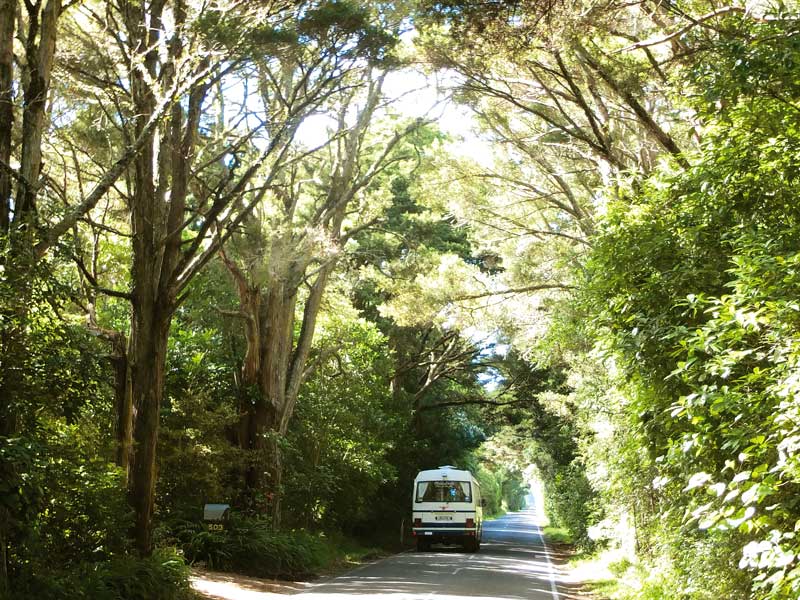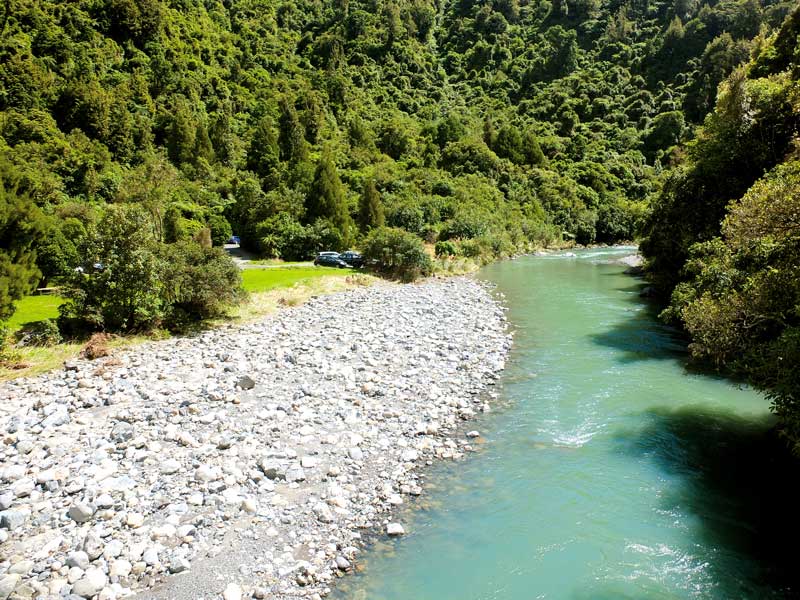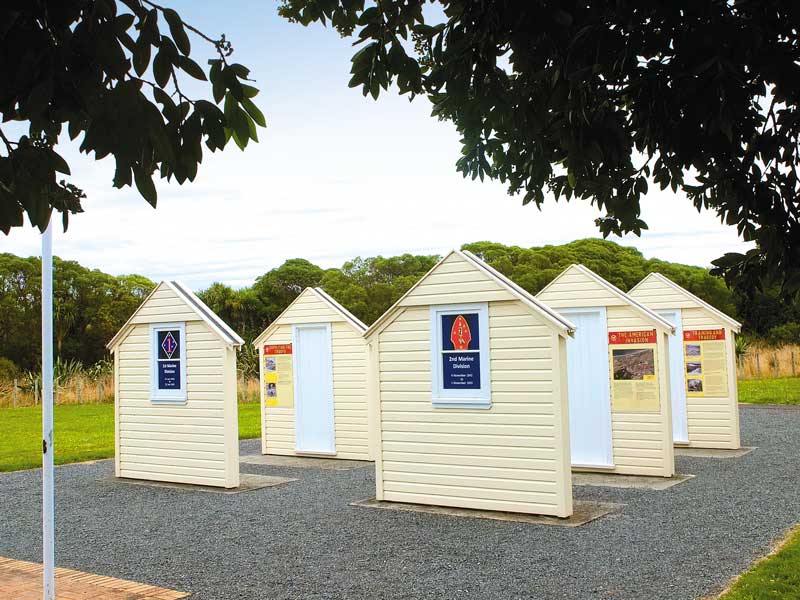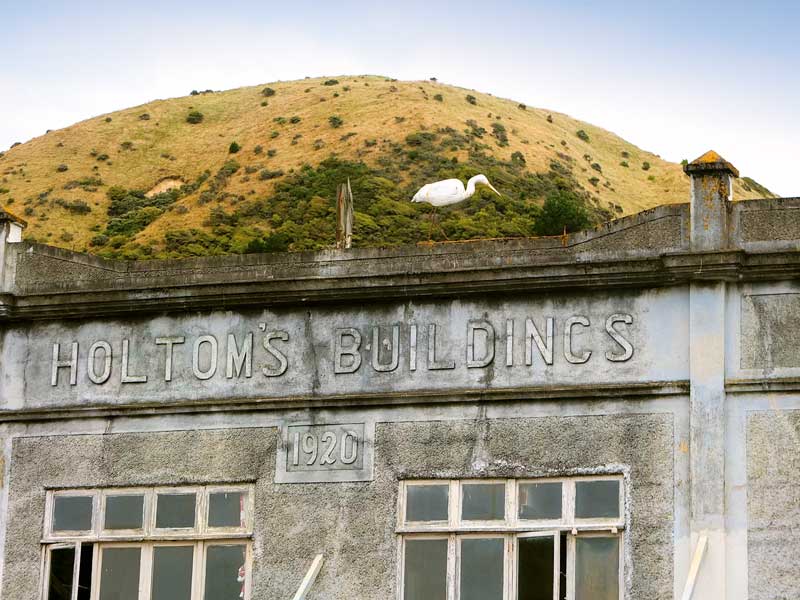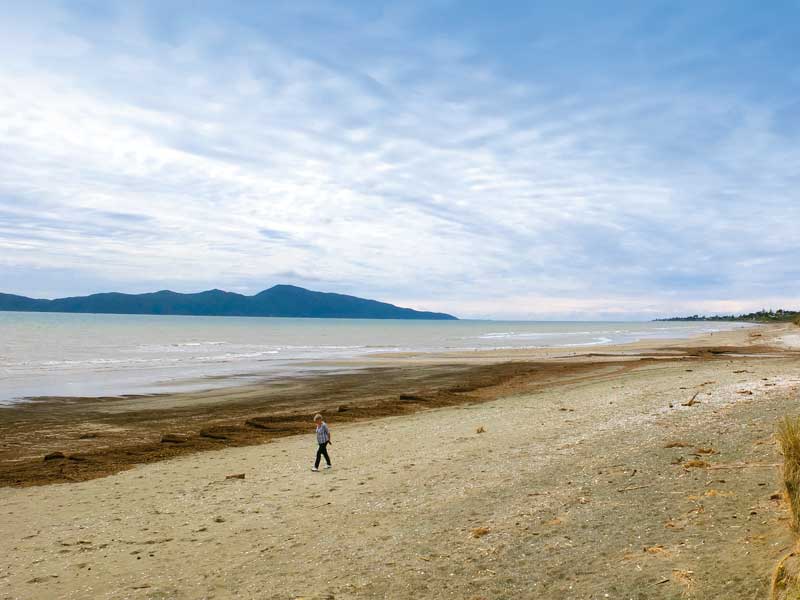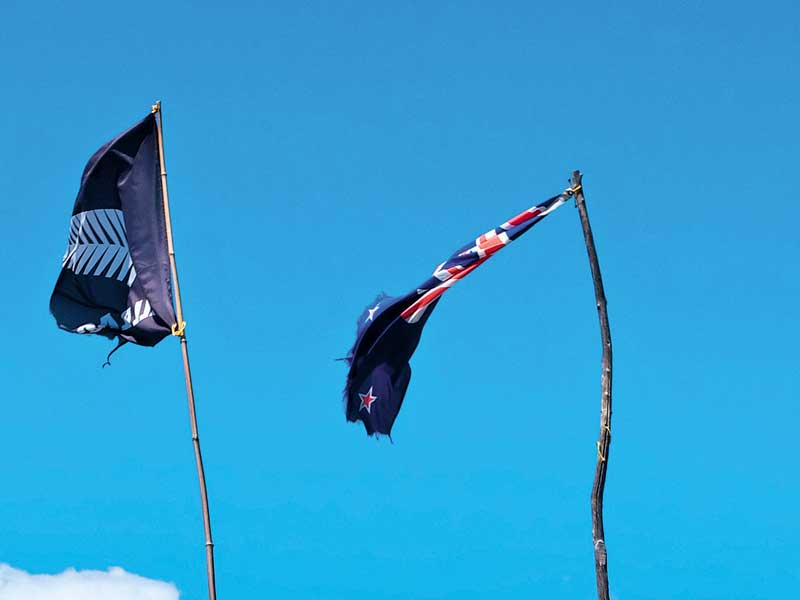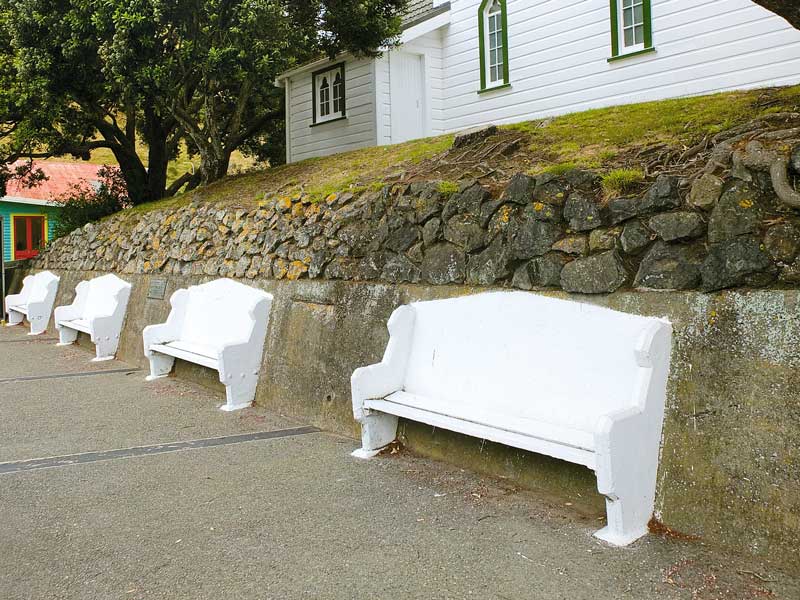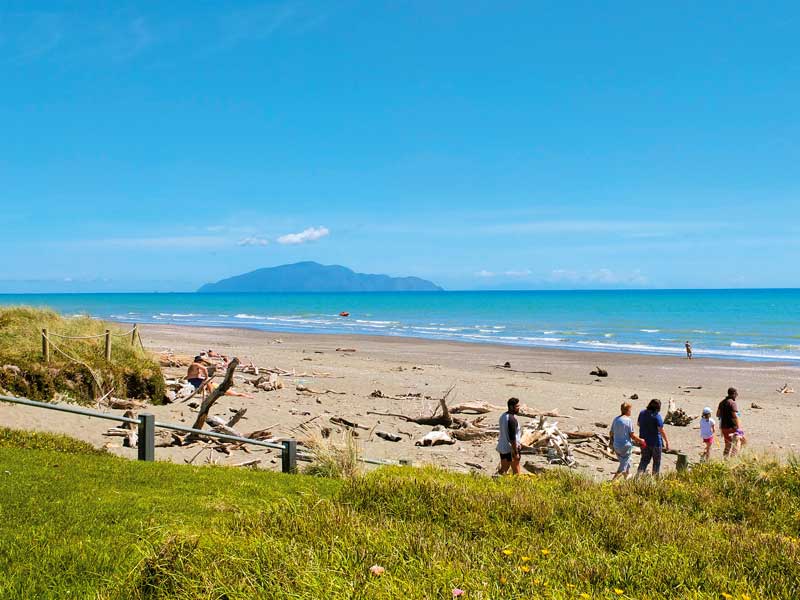The Kapiti Coast roughly begins at Paekakariki and ends somewhere north of Otaki. I say roughly because ask locals the question and you could get a wide range of answers. I asked a sweet-faced, bald-headed man who was down on his knees weeding a patch of marigolds in his Paekakariki garden.
“People can say what they like,” he grinned, standing to deliver me his message. “I’ve lived ‘ere 50 years and I know the Kapiti Coast like the back of m’hand. It starts ‘ere and finishes up around Otaki.”
That will do me.
Paekakariki, wedged on a narrow ledge between the Tasman Sea and the steep hills of the Akatarawa Range, is a zany little village, which is fighting to keep its old character intact. In an effort to jazz things up, a store on one side of the street is painted bright orange, the old hall opposite is lemon, and outside St Peter’s Church a row of bench seats have faux backs painted on the wall behind them. Two large teddy bears squat in the bushes outside The Perching Parrot cafe, which seems to be the hub of village life, and the statue of a white heron perches on the roof of the aged, but once stately, Holtom’s Building (1920). Across the road, the historic Paekakariki Hotel has already succumbed to the hammer and in its place is the modern Finns Hotel, which includes an art house cinema. Not every local is impressed.
Paekakariki Railway Station, which has survived since 1886, comprises buildings that that will never come down. All services travelling between Paraparaumu and Wellington still stop at this attractive old building, which is protected by a Historical Places Trust rating.
The station also houses a well-presented museum and bookshop that specialises in rare books and collections on spirituality, Maori, and railways. It is run by two knowledgeable bookworms, Irving Lipshaw and Michaeal O’Leary. The newly opened Paekakariki Escarpment Walk leaves from the station’s platform.
As I perched in the ‘Parrot’ consuming a rather delicious marinated tofu salad, a slim, red-faced German man joined me at the table. He had just returned from the walkway. It had taken him three hours one way, much of it straight uphill.
“There are 500 steps but great views,” he said. “You should do it sometime.”
I don’t think so. There are other ways to find a view.
We stayed at the Paekakariki Holiday Park, which is spacious and leafy with each site separated by chest-high hedges. The amenities are time-worn but clean and tidy. The park is tucked into a corner of Wellington’s favourite playground, the 650ha terrain of Queen Elizabeth Park that encompasses the last remnant of the muscular sand dunes, which once stretched the length of the coast. As part of the coast’s natural heritage, a great effort is being made to restore these and they are now covered in low scrub.
We walked part of the gravel path that undulates across the dunes and the foreshore of grey sand that seems to go on forever. A mass of trunks and branches of dead trees have found their way onto the beach and their bleached shapes stick up from the sand like gatherings of ghosts.
Ghosts and garrisons
There are other ghosts in Queen Elizabeth Park. In 1942, the public works department constructed three camps for the 20,000 American Marines who trained here for the Pacific Campaign of WW2. It was considered an ideal site. The marines practised landings on the beach and jungle warfare in the Tararua Ranges.
Those days, which at the time so profoundly influenced coastal life, are remembered on billboards, names of tracks, museums, and a captivating memorial made of life-sized hut facades explaining the details of the occupation. Surrounding the restored wetland is a grove of kahikatea, planted to honour the marines who never made it back from battle. The camps apparently stocked Hershey bars and Coca Cola and erected the first takeaway hamburger bar in New Zealand so the men would feel more at home.
Across SH1 at Mackay’s Crossing is Whareroa Farm. It was also a marine camp in WW2, then passed to Lands and Survey and eventually to Landcorp, which closed it to the public and in 1993, revealed plans to subdivide it for private ownership. The outcry to save the rural landscape reverberated through the country and a rigorous campaign to change the outcome was eventually successful. The farm is now under the DOC umbrella and numerous walkways lead through the hills that once swarmed with fighting men.
We walked the Coastal Lookout Trail, a small version of the long haul up the Paekakariki Escarpment, and there was our view. The dunes formation, furred with grasses and stunted trees was evident, their rounded mounds loping up and down the coastline. Beyond was Kapiti Island shadowed and clear-cut again a pearly white sky. Toy cars hummed down SH1 and we could see from Farewell Spit to the Kaikouras.
Feathering the future
Other aspects of the coast’s natural heritage are also being safeguarded. From all angles, Kapiti Island dominates the seascape. I gazed at it and conjured up another ghost, this time of the great Chief Te Rauparaha and the Ngati Toa warriors, who in 1822, had so bravely defended their possession of the island. Later inhabitants introduced dogs, cats, possums, goats, and rats, which ravaged the forests until a group of naturalists urged the government to acquire the island as a sanctuary, which it did under contentious circumstances that still rankle today. That aside, the island has flourished since being given reserve status and relieved of its pests. Native forest now reclaims the island and native birds are thriving. Day and overnight trips leave from Paraparaumu.
Back on the mainland, the Waikanae River slides into the Tasman Sea, spreading first into a wide estuary, which is a haven for waders and water birds. But it’s not only the birds that are the attraction. The estuary itself is a beautiful ever changing part of the coastline. The estuary is a scientific reserve and one of the zealously protected jewels of the Kapiti Coast. It was a privilege to be able to stay the night in the freedom camping area right next to the estuary and the beach at the end of Tutere Street.
Inland and north of the Waikanae Estuary, 35ha of coastal wetland make up the Nga Manu Nature Reserve where there is a good opportunity to get up close and personal with wildlife in a natural setting. Easy pathways leading through the bush meant I could spend more time observing flora and fauna instead of watching my feet. More than 56 species of bird come and go around the wetland.
Forks and fires
Further north, we turned towards the Tararua Ranges on a narrow road, which twists giddily through deep valleys and high ledges to arrive at Otaki Forks. We had left the caravan behind, which turned out to be the right decision. The road is narrow and part of it gravelled. Just ahead of us, a seven-metre RV bus was snaking along the route, the driver slowing and evidently a little anxious on the blind corners.
When we arrived at the first DOC camping ground, the smaller of the two, he climbed down from the cab, blowing out his cheeks and looking relieved.
“That was bleedin’ interesting. I’m from England,” he announced to nobody in particular. I couldn’t quite see how that made a difference.
I don’t want to put anybody off because it is a lovely spot, but drivers of larger rigs might want to take advice on the state of the road before they set off. It was closed in 2015 because of a large slip, which is now cleared but still in evidence. There are two lovely riverside DOC camping areas if you can get there. The larger one is closed for the winter.
The Forks is the western entrance to the Taraua Forest Park where two tributaries meet to form the Otaki River. That day was mild and calm but the Tararuas have a formidable reputation for weather. It’s one of the windiest places in New Zealand, and the summits are mostly obscured by mists and cloud. But the Forks has a legacy of human occupation. The bush was milled, settlers moved in and a rough village served some of their needs. Gold-mining was undertaken by a group of Seventh Day Adventists and an orphanage was opened next to the school. There’s not much left of that habitation but remnants of milling machinery lie rusting in the long grasses and a web of old farmstone walls at Shields Flat is now a historic reserve.
For more intact historical evidence, I was directed back to Otaki township. “You must go to the new historic church,” said my informant, obviously unaware of the oxymoron.
The original Rangiatea Church, the first Maori church in New Zealand, was built in 1851 under the direction of an English missionary called Octavius Hadfield and the great warrior, Te Rauparaha, in a street given his name. It was an extraordinary blend of Maori and European design, decorated inside with elaborate, painted Maori design on the ceiling and intricate tuku tuku panelling on the walls. It was an enormous loss when a local arsonist burnt it to the ground in 1995. By 2003 an almost exact replica had been rebuilt and the church is now as it was—on the outside an unadorned white-painted timber church, inside a lasting tribute to both its past and present creators.
It is one of the most obvious examples of saving the past for the future on the Kapiti Coast.


